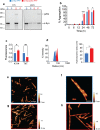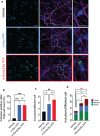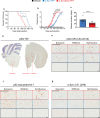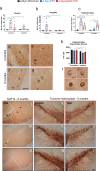Multiple system atrophy-associated oligodendroglial protein p25α stimulates formation of novel α-synuclein strain with enhanced neurodegenerative potential
- PMID: 33978813
- PMCID: PMC8217051
- DOI: 10.1007/s00401-021-02316-0
Multiple system atrophy-associated oligodendroglial protein p25α stimulates formation of novel α-synuclein strain with enhanced neurodegenerative potential
Abstract
Pathology consisting of intracellular aggregates of alpha-Synuclein (α-Syn) spread through the nervous system in a variety of neurodegenerative disorders including Parkinson's disease, dementia with Lewy bodies, and multiple system atrophy. The discovery of structurally distinct α-Syn polymorphs, so-called strains, supports a hypothesis where strain-specific structures are templated into aggregates formed by native α-Syn. These distinct strains are hypothesised to dictate the spreading of pathology in the tissue and the cellular impact of the aggregates, thereby contributing to the variety of clinical phenotypes. Here, we present evidence of a novel α-Syn strain induced by the multiple system atrophy-associated oligodendroglial protein p25α. Using an array of biophysical, biochemical, cellular, and in vivo analyses, we demonstrate that compared to α-Syn alone, a substoichiometric concentration of p25α redirects α-Syn aggregation into a unique α-Syn/p25α strain with a different structure and enhanced in vivo prodegenerative properties. The α-Syn/p25α strain induced larger inclusions in human dopaminergic neurons. In vivo, intramuscular injection of preformed fibrils (PFF) of the α-Syn/p25α strain compared to α-Syn PFF resulted in a shortened life span and a distinct anatomical distribution of inclusion pathology in the brain of a human A53T transgenic (line M83) mouse. Investigation of α-Syn aggregates in brain stem extracts of end-stage mice demonstrated that the more aggressive phenotype of the α-Syn/p25α strain was associated with an increased load of α-Syn aggregates based on a Förster resonance energy transfer immunoassay and a reduced α-Syn aggregate seeding activity based on a protein misfolding cyclic amplification assay. When injected unilaterally into the striata of wild-type mice, the α-Syn/p25α strain resulted in a more-pronounced motoric phenotype than α-Syn PFF and exhibited a "tropism" for nigro-striatal neurons compared to α-Syn PFF. Overall, our data support a hypothesis whereby oligodendroglial p25α is responsible for generating a highly prodegenerative α-Syn strain in multiple system atrophy.
Keywords: Multiple system atrophy (MSA); P25α; Protein aggregation; Strains; Tubulin polymerisation-promoting protein (TPPP); Α-Synuclein.
Conflict of interest statement
The authors declare no competing interests.
Figures








Similar articles
-
Endogenous oligodendroglial alpha-synuclein and TPPP/p25α orchestrate alpha-synuclein pathology in experimental multiple system atrophy models.Acta Neuropathol. 2019 Sep;138(3):415-441. doi: 10.1007/s00401-019-02014-y. Epub 2019 Apr 22. Acta Neuropathol. 2019. PMID: 31011860 Free PMC article.
-
Oligodendrocytes Prune Axons Containing α-Synuclein Aggregates In Vivo: Lewy Neurites as Precursors of Glial Cytoplasmic Inclusions in Multiple System Atrophy?Biomolecules. 2023 Feb 1;13(2):269. doi: 10.3390/biom13020269. Biomolecules. 2023. PMID: 36830639 Free PMC article.
-
SNCA and TPPP transcripts increase in oligodendroglial cytoplasmic inclusions in multiple system atrophy.Neurobiol Dis. 2024 Aug;198:106551. doi: 10.1016/j.nbd.2024.106551. Epub 2024 Jun 3. Neurobiol Dis. 2024. PMID: 38839023
-
ɑ-Synuclein strains and the variable pathologies of synucleinopathies.J Neurochem. 2016 Oct;139 Suppl 1:256-274. doi: 10.1111/jnc.13595. Epub 2016 Mar 30. J Neurochem. 2016. PMID: 26924014 Review.
-
Structural and Functional Insights into α-Synuclein Fibril Polymorphism.Biomolecules. 2021 Sep 28;11(10):1419. doi: 10.3390/biom11101419. Biomolecules. 2021. PMID: 34680054 Free PMC article. Review.
Cited by
-
20S proteasome enhancers prevent cytotoxic tubulin polymerization-promoting protein induced α-synuclein aggregation.iScience. 2024 Jun 4;27(7):110166. doi: 10.1016/j.isci.2024.110166. eCollection 2024 Jul 19. iScience. 2024. PMID: 38974969 Free PMC article.
-
Multiple System Atrophy: Advances in Diagnosis and Therapy.J Mov Disord. 2023 Jan;16(1):13-21. doi: 10.14802/jmd.22082. Epub 2022 Dec 20. J Mov Disord. 2023. PMID: 36537066 Free PMC article.
-
Amyloids as Building Blocks for Macroscopic Functional Materials: Designs, Applications and Challenges.Int J Mol Sci. 2021 Oct 2;22(19):10698. doi: 10.3390/ijms221910698. Int J Mol Sci. 2021. PMID: 34639037 Free PMC article. Review.
-
⍺-Synuclein Structural Diversity and the Cellular Environment in ⍺-Synuclein Transmission Models and Humans.Neurotherapeutics. 2023 Jan;20(1):67-82. doi: 10.1007/s13311-023-01365-5. Epub 2023 Apr 13. Neurotherapeutics. 2023. PMID: 37052776 Free PMC article. Review.
-
Transcriptional dysregulation in the cerebellum triggered by oligodendroglial α-synucleinopathy: insights from a transgenic mouse into the early disease mechanisms of MSA.J Neural Transm (Vienna). 2025 Feb 15. doi: 10.1007/s00702-025-02892-5. Online ahead of print. J Neural Transm (Vienna). 2025. PMID: 39954078
References
-
- Aoki N, Boyer PJ, Lund C, Lin WL, Koga S, Ross OA, et al. Atypical multiple system atrophy is a new subtype of frontotemporal lobar degeneration: frontotemporal lobar degeneration associated with alpha-synuclein. Acta Neuropathol. 2015;130:93–105. doi: 10.1007/s00401-015-1442-z. - DOI - PMC - PubMed
Publication types
MeSH terms
Substances
Grants and funding
LinkOut - more resources
Full Text Sources
Other Literature Sources
Medical
Molecular Biology Databases
Miscellaneous

